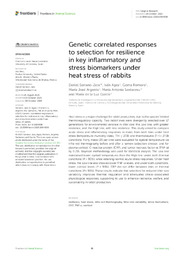Please use this identifier to cite or link to this item:
https://hdl.handle.net/11000/37759Full metadata record
| DC Field | Value | Language |
|---|---|---|
| dc.contributor.author | Serrano-Jara, Daniel | - |
| dc.contributor.author | Agea, Iván | - |
| dc.contributor.author | Romero, Gema | - |
| dc.contributor.author | Argente, María José | - |
| dc.contributor.author | Santacreu, María Antonia | - |
| dc.contributor.author | García, María de la Luz | - |
| dc.contributor.other | Tecnología agroalimentaria | es_ES |
| dc.date.accessioned | 2025-10-31T10:36:28Z | - |
| dc.date.available | 2025-10-31T10:36:28Z | - |
| dc.date.created | 2025-10-28 | - |
| dc.identifier.citation | Frontiers in Animal Science; Volumen 6 - 2025 | es_ES |
| dc.identifier.issn | 2673-6225 | - |
| dc.identifier.uri | https://hdl.handle.net/11000/37759 | - |
| dc.description.abstract | Heat stress is a major challenge for rabbit production, due to the species’ limited thermoregulatory capacity. Two rabbit lines were divergently selected over 17 generations for environmental variance in litter size: the Low line, with greater resilience, and the High line, with less resilience. This study aimed to compare acute stress and inflammatory responses in males from both lines under heat stress (temperature–humidity index, THI ≥ 27.8) and thermoneutral (THI< 27.8) conditions. Forty males (20 per line) were evaluated for eyeball temperature via infra-red thermography before and after a semen collection stressor, and for plasma cortisol, C-reactive protein (CRP), and tumor necrosis factor-a (TNF-a) by ELISA. Bayesian methodology was used for statistical analysis. The Low line maintained lower eyeball temperatures than the High line under both thermal conditions (P > 90%), while retaining normal acute stress responses. Under heat stress, the Low line also showed lower TNF-a levels, and under both conditions, lower cortisol levels (P > 90%). CRP did not differ between lines or thermal conditions (P< 90%). These results indicate that selection for reduced litter size variability improves thermal regulation and attenuates stress-associated physiological responses, supporting its use to enhance resilience, welfare, and sustainability in rabbit production | es_ES |
| dc.format | application/pdf | es_ES |
| dc.format.extent | 8 | es_ES |
| dc.language.iso | eng | es_ES |
| dc.publisher | Frontiers Media | es_ES |
| dc.rights | info:eu-repo/semantics/openAccess | es_ES |
| dc.rights.uri | http://creativecommons.org/licenses/by-nc-nd/4.0/ | * |
| dc.subject | resilience | es_ES |
| dc.subject | heat stress | es_ES |
| dc.subject | infra-red thermography | es_ES |
| dc.subject | litter size variability | es_ES |
| dc.subject | stress biomarkers | es_ES |
| dc.subject | CRP | es_ES |
| dc.subject | TNF-a | es_ES |
| dc.subject | cortisol | es_ES |
| dc.subject.other | CDU::6 - Ciencias aplicadas::66 - Ingeniería, tecnología e industria química. Metalurgia | es_ES |
| dc.title | Genetic correlated responses to selection for resilience in key inflammatory and stress biomarkers under heat stress of rabbits | es_ES |
| dc.type | info:eu-repo/semantics/article | es_ES |
| dc.relation.publisherversion | 10.3389/fanim.2025.1694508 | es_ES |

View/Open:
fanim-6-1694508.pdf
498,71 kB
Adobe PDF
Share:
.png)
